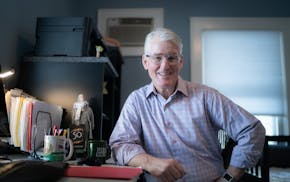It's easy to support the goals of a Walz administration policy initiative called Clean Cars Minnesota.
It's the way those goals are accomplished that makes it hard to jump on board.
Gov. Tim Walz wants more Minnesotans to buy electric and hybrid vehicles, which would be good for Minnesota and help at least a little in addressing climate change. And we are late adopters, in the state and in the country.
But it's generally a good idea when you want a change in a marketplace to provide some incentives. Clean Cars Minnesota is a proposal by a regulator, the Minnesota Pollution Control Agency (MPCA). And regulators only make and enforce rules.
Those rules, which follow California's on emissions, are aimed at car manufacturers, but it's Minnesota's car dealers who are doing the worrying.
If implemented, car dealers will have to figure out how to make the rules work, as that's what business owners do. But maybe the best outcome is that the transition to electric vehicles accelerates enough for the rules not to matter all that much.
California'severe air-quality problems led to a carve-out from federal air pollution legislation decades ago. From 2012 through 2020, though, California's rules on new-car emissions were in line with the federal government's.
Minnesota car dealers aren't happy with the notion of following a standard if no one else in the Upper Midwest does. But enough additional states have already adopted this approach, said Craig McDonnell, an MPCA assistant commissioner for air and climate policy, that the industry may just adopt California's standards nationwide.
Some big car companies, Ford Motor, Honda and Volkswagen among them, have already agreed with California to do that.
But if Minnesota did have cars for sale built to a different standard, that could make it harder to swap inventory with dealers in other states.
An even bigger problem for dealers is the proposed requirement that manufacturers deliver a proscribed amount of electric and plug-in hybrid vehicles to Minnesota.
Sales of plug-in electric vehicles haven't reached 2% of the market, and under the proposed Clean Cars Minnesota rules, the deliveries here would move up to 6% to 7.5%.
It will be a flexible system of compliance credits based on the specific cars, with long-range, fully electric cars generating the highest compliance credits, as described by McDonnell and one of his colleagues. Manufacturers can also trade credits with each other and help move inventory to where the consumer demand is the greatest.
Admittedly, this didn't sound all that onerous. On the other hand, big manufacturers have a way of making their headaches their dealers' headaches. Ford Motor and Honda don't consign inventory to dealers, keeping the risk of loss. They sell new cars to dealers.
So whether there are going to be enough electric car buyers in Minnesota isn't going to be only a manufacturer problem.
Minnesota's dealers are happy to embrace electric vehicles, said Scott Lambert and his colleague Amber Backhaus of the Minnesota Automobile Dealers Association. The dealers just don't want rules aimed at the manufacturers to hit them instead.
A scan of a few Twin Cities dealer websites for what's available right now showed a big range, from a single Mustang Mach-E at a big suburban Ford dealer (still in transit) to 56 fully electric Audi e-trons at Audi Minneapolis, based in Golden Valley.
This Audi retailer doesn't really have that many, said General Manager Todd Olson, with some still in transit. But it does have a lot of them and they are selling, maybe 5% to 10% of new-car sales.
Some buyers are new to the Audi brand and motivations vary, too, from a desire to cut carbon pollution to lower maintenance and fuel costs. Olson said he is looking forward to new models, too, including a lower-priced electric crossover SUV.
These new Audi cars for sale now are at the luxury end of the market, but one dealer with two locations having more than 50 to choose from is yet another sign of how quickly this market might change.
The most surprising recent change of heart might have been at General Motors, which just said its goal is to be completely out of making gas-powered and diesel-powered vehicles by 2035. GM lately has seen just a small sliver of sales from EVs and doesn't make money building them.
GM produced a spot with comedy stars Will Ferrell, Kenan Thompson and Awkwafina — and an electric Cadillac that's still far from first deliveries — to introduce Americans during the Super Bowl to its new strategy. And football fans heard about Norway.
In the ad, Ferrell was infuriated that Norway sells more electric cars per person than the U.S. And maybe the story of Norway's car-business evolution is worth hearing more about.
More than half of sales in Norway last year were of fully electric vehicles, and by adding plug-in hybrid cars the total is more like three-quarters of new car sales. A decade ago, battery electric cars were just 1% of sales.
The story of how that transformation happened goes back decades, to when a couple of founders of a popular 1980s rock band brought a converted electric Fiat into Norway and then refused to pay road tolls, park where they were supposed to or stay out of bus lanes.
Authorities confiscated the little car — repeatedly — but they kept at it. Eventually road tolls and parking fees were waived for electric car owners.
The full picture in Norway includes several taxes on conventional vehicles, including one on carbon pollution. The economic case for that kind of tax is pretty much bulletproof, but it has not caught on here.
But with all this added up, a $21,500, conventionally powered Volkswagen subcompact becomes more like a $35,000 purchase. And the $31,000 electric e-Golf looks pretty cheap, as described in a 2019 side-by-side comparison published by Clean Car Reports.
Given that mix of taxes and incentives, it's doubtful Norwegian car dealers ever worry about too many EVs in inventory.

Schafer: What do you really need to retire?

Schafer: How doing business can be a bit more like Christmas morning

Schafer: There won't soon be another opportunity to rethink the I-94 corridor

Schafer: The fruits of Honeywell's long-game dedication to quantum computer now being seen


